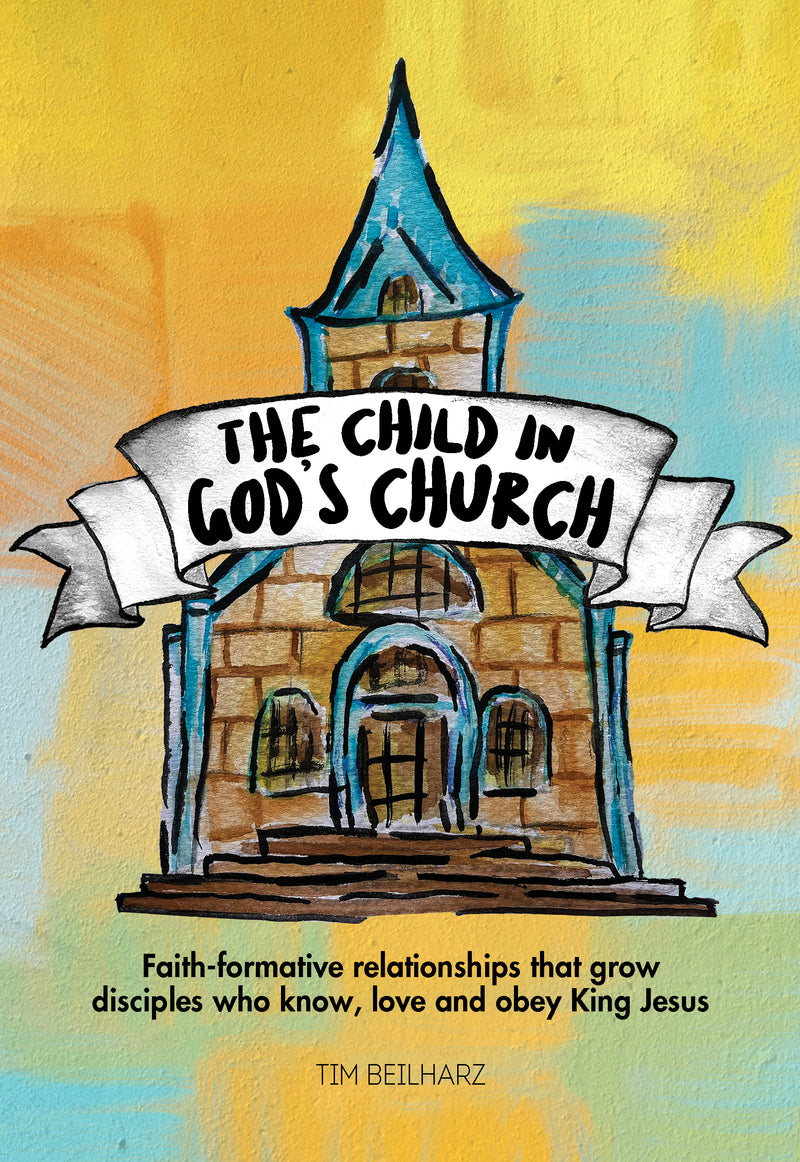
How do parents influence their children’s faith?
Introducing ‘The Child in God’s Church’ by Tim Beilharz.
Both the Old and New Testaments state that God has particularly given parents and households the responsibility to disciple children. And yet, simultaneously, he has also given Christians to each other in the church. These discipleship loci establish the two foundational principles of family ministry that Reggie Joiner articulates in his key family ministry texts Think Orange and Parenting Beyond Your Capacity (David C. Cook, 2010). First Joiner exhorts parents that:
No-one has more potential to influence your child than you … Teachers, pastors and coaches will never have as much potential to influence a child’s character, self-esteem, perspectives or faith as a parent does. (Parenting Beyond Your Capacity, p. 27)
This principle affirms households as the primary place of faith formation for the believing child, theologically built on God’s redemptive purposes found in family faith transmission in both in the Old and New Testament. Then Joiner expresses the second principle of family ministry in his encouragement to parents that:
… your present family will never be enough for your children. Even the best parenting in the best family will never alone be enough to develop relationally, emotionally and spiritually healthy children … You are not the only influence your children need. (Parenting Beyond Your Capacity, pp. 29–30)
This second principle affirms the importance of the church community in the discipleship of children. Earlier in this book, we hinted towards the corporate context of passages such as Deuteronomy 6 and the relative de-emphasising of biological families in light of the primary family of God centred on Christ. We will explore these themes more fully in the next chapter.
For now, we will explore further the effectiveness of parents in discipling children, reviewing some significant research that uncovers the sociological and relational dynamics at work, which God, in his wisdom, uses to pass on faith from generation to generation.
The faith of parents
For children belonging to Christian households, the faith of the parent plays an essential role in the faith of the child . In the words of sociologists Christian Smith and Amy Adamczyk in their book Handing Down the Faith (Oxford University Press, 2021):
Parents define for their children the role that religious faith and practice ought to play in life, whether important or not, which most children roughly adopt. Parents set a ‘glass ceiling’ of religious commitment above which their children rarely rise. (Handing Down the Faith, p. 69.)
We can see the evidence of this in the data from my own denominational context, captured in the National Church Life Survey conducted every five years across Australia. Two questions connect the relevance of parental faith to the faith of children in the household. The first asks, ‘How old were you when you first became a Christian?’ The second relevant question asks, ‘When you were around 12–15 years of age, were your parents committed Christians?’ It is at the intersection of these two questions that we see the influence of parents’ own faith on the faith commitment of their children.
In a report on this survey, Becoming a Christian (2018, Anglicare), we can see that for Sydney Anglicans who responded to the survey in 2016, 65% who stated that they became a Christian during their childhood or adolescent years had one or both parents who were committed Christians when the respondent was between 12 and 15 years. Just over 18% who became Christians at the same age had neither parent as a committed Christian at that time. By comparison, Sydney Anglicans who reported that they became a Christian after the age of 20 were far more likely to have had non-Christian parents during their adolescence (45%) and far less likely to have come from homes with either one or both parents having a committed faith (24%). This shows a strong correlation between the faith of parents and the faith of the child.
In the same survey, adult respondents who had children aged up to 35 years were asked if their child currently attends a church, as well as the religious activities that parent engaged in with the child when that child was growing up. Of the several factors that respondents could indicate, the strongest association between childhood practices and continued attendance was reading the Bible and praying together. Of those children up to 35 years of age who continued to attend a church, 83% had been read to by and prayed with their parent. By contrast, only 61% of those same aged children who were no longer attending church had engaged in the same discipleship practices with their parents.
In summarising these results, the report’s author concludes:
Although the associations between current attendance patterns and religious activities in childhood are generally weak, it appears that the presence of direct spiritual activity involving both parent and child is more closely associated with the child’s current attendance than children’s ministry activities while growing up. Therefore, it will be important for … local parishes to consider not only which ministry activities need to be provided to cater for children as they move through life stages, but also how to best equip parents to provide spiritual nurture directly and effectively to their children. (Becoming a Christian, p. 19)
Therefore, while it does not inoculate children against walking away from faith, intentional engagement in faith practices by parents plays an important role in the faith development and retention of children.
Beyond Bible and prayer time
Smith and Adamczyk found similar results in their research on successful faith transmission across various faiths groups in the USA: ‘Parents who engaged in religious activities with their children when they were young were more likely to have adult children who were similarly religious’ (Handing Down the Faith, p. 45). What was striking about Smith and Adamczyk’s research was that it was not the structured reading of the Bible or praying with children that had the strongest association with successful faith transmission, but rather the unstructured, ad hoc conversations about faith that occurred in the home. The authors suggest that these impromptu conversations solidify the importance of faith in the life of the child by, perhaps counterintuitively, integrating faith-talk into the ordinariness of everyday conversation.
Their rationale for the significance of ordinary faith-talk conversations is worth quoting in full:
People usually talk about what they care about, whether it be sports, politics, music or romantic relationships. Some people are indeed very private about religion, and others are reserved in their speech generally. But normally talk about something indicates that it matters to the talker. When all parents say about religion to children during a week is something like ‘OK, everyone, leaving for church in 30 minutes’, that is telling. When conversations immediately turn after religious worship services to non-religious interests, that is telling, too. The messages may be subliminal, but their accumulated socialisation effects are powerful. By contrast, when parents talk naturally and substantively about religion and its place in life throughout the week, that effectively indicates to children that, in the mix of life’s many priorities and values, this stuff matters a lot. And that raises the stakes for children’s decisions about their own future religious commitments. (Handing Down the Faith, p. 83)
Research from both sides of the Pacific shows the effectiveness of family ministry as a key factor in childhood faith development, which ought not to surprise those familiar with the biblical narrative. Additionally, in Scripture we see God’s commands for both structured and unstructured faith-talk conversations in the family setting, whether it be during the eating of the Passover meal or family trips to the River Jordan (Exodus 12:24–28; Joshua 4:4–7). Therefore, our churches and children’s ministries cannot neglect the family. Those involved in these ministries do have a legitimate responsibility to ‘tell the next generation the praiseworthy deeds of the Lord’ (Psalm 78:4), and yet do so in light of the fact that the primary responsibility for discipleship remains with the parents.
References
Smith C & Adamczyk A (2021), Handing Down the Faith, Oxford University Press.
Bellamy J (2018), Becoming a Christian: Key Influences on Faith Formation and Church Attendance [report], Anglicare, Sydney, pp. 8–24.
Joiner R & Nieuwhof C (2010), Parenting Beyond Your Capacity, David C. Cook.
---
Tim Beilharz is the author of The Child in God’s Church: Faith-Formative Relationships that Grow Disciples Who Know, Love and Obey King Jesus and a contributing author to Parenting in God's Family: Biblical Wisdom for Everyday Issues. He is also the Children’s Pastor at Soul Revival Church in Sydney and lectures in Children’s and Intergenerational Ministry at Youthworks College. Tim lives in the southern suburbs of Sydney with his family, where they don’t have much, but they do have books.

The Child in God's Church
In The Child in God’s Church, Tim Beilharz provides the biblical reasons for including and nurturing children as precious members of the body of Christ.
For more articles from Growing Faith, subscribe to our monthly e-newsletter.
To hear about the latest books and resources from Youthworks Media, subscribe here.








